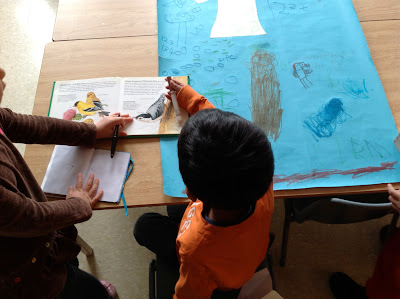 |
| Some PM class friends watching starlings and robins hunting worms in the rain. |
In the FDEL-K the skills and attitudes displayed by children who undertake their own projects are best described by this expectation from the Personal and Social area of the document:
Overall Expectation 2: demonstrate independence, self-regulation, and a willingness to take responsibility in learning and other activities
2.3 demonstrate self-motivation, initiative, and confidence in their approach to learning by selecting and completing learning tasks (e.g., choose learning centres independently, try something new, persevere with tasks)
Full-Day Early Learning - Kindergarten Program (draft) pp. 63-64
Students in my classes know that in order to be asked to share during "sharing time", they must sign up with some sort of note, even if it is an artifact that they wish to share. During the last month, the topic of birds has led to interesting "noticings" being posted about different bird behaviours. Here at the left, two boys in the afternoon class are using binoculars, consulting the bird field guides, and writing a note to share with the class.
Here students are using the pictures and known words to learn about interesting birds to add to their collaborative research poster. I had put the blue paper out one day as a provocation, with the title "What We Know About Birds". I had chosen some recycled bulletin board paper to match the blue of our birdwatching poster. The invitation was taken up by J who carefully drew and labeled the body parts of a robin while a friend drew a woodpecker flying in from the side. When the afternoon friends saw the work, several students were excited about adding what they had learned to the bottom, requesting that I show the morning friends what they had to teach.
When my students are interested in a particular topic, even if it is a small group engaged in the inquiry, I like to find links to sites and video clips for them to explore further. I link these on my PDSB-hosted class site for students to access at home whenever they like. It is here that I share our Voicethread books, photos from each month in class, and news. For the growing group of birdwatchers I linked videos of specific local songbirds and one heart-breaking, lovely video about a robin's nest from egg to flight.
We were so engaged in our latest project that I was finding it difficult to visit the "We Can See" blog these days, with so much of our time at the end of the day being dedicated to sharing our daily learnings. I was happy with the direction of the talk each day, even if it meant some days there was simply no time even for a read-aloud. It was a very happy moment indeed, when morning friend J suggested we make our own "We Can See" book, not about spring, but about birds! I told her I would share her idea with the afternoon class, and gave her a high five for such a marvelous idea.
Here is our book, so far. The wonderful thing about making a Voicethread book is that it is very easy to add on each day as new ideas come forth. Next week the book will certainly have grown!
Here is our book, so far. The wonderful thing about making a Voicethread book is that it is very easy to add on each day as new ideas come forth. Next week the book will certainly have grown!
"We can see birds!" (click here to see/hear Voicethread book)
Last week, the morning friends and I went for a walk with our friends from down the hall: Ms. Silva's class. We had some exciting encounters, some of which are sure to show up in our Voicethread. The story of our bird-watching walk, along with some of the individual "I Can See Birds" books, will be the subject of part three.







Our class watched/listened to your class book on the We Can See blog page.
ReplyDeleteWe have left your class some compliments and questions.
Kim
Hi Kim,
ReplyDeleteThank you for sharing with your class. My students were so happy to hear from friends in another room 109 Kindergarten! They had more questions about your letter.
We also watched your new spring movie. Both classes enjoyed it and had comments and questions for your class. Now, if only my board didn't block Skype! Perhaps we could try Peel's "Big Blue Button" and chat sometime. My bird experts are keen to share their learning.